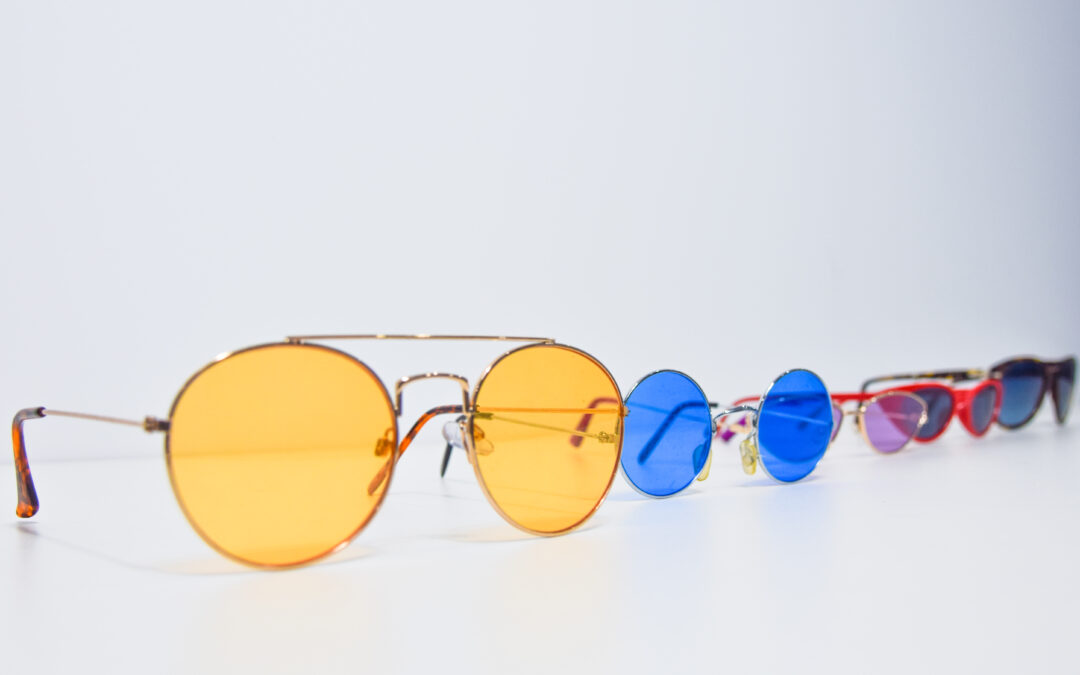We bet you didn’t see this one coming! Our last Iconic Plastic Product has made quite the spectacle in the fashion world, whilst doubling with the benefit of protecting your eyes from harmful rays of light.
Originally created to simply reduce the annoying glare of the sun, they now are used for a variety of purposes, demonstrating how design can take on a new perspectives and adapt. Sunglasses can also make you look super cool, and can help you maintain a serious poker face!
Date of Invention:
 Sunglasses have been around since the 12th Century, originating from China and adopted by court figures who would use the smokey quartz lenses to hide facial expressions and conceal their judgements. They were only worn by the wealthy and were pretty ineffective at protecting their eyes from harmful UV rays.
Sunglasses have been around since the 12th Century, originating from China and adopted by court figures who would use the smokey quartz lenses to hide facial expressions and conceal their judgements. They were only worn by the wealthy and were pretty ineffective at protecting their eyes from harmful UV rays.
However, sources state that there were primitive sunglasses even before this, used by the Inuit in prehistoric times to protect them from the blinding snow. These were made from walrus ivory, and had no frames but instead just two thin slits carved into a slab.
In the mid 1700s, a London optician discovered the emerald tinted lens, which is supposedly the best colour for UV protection, however the modern sunglasses as we know them were not invented until the 20th century by Sam Foster in New Jersey. This effectively kicked off the 1930s with a new and affordable fashion movement. It was also in the 1930s that the polarized lens also came into the picture, in perhaps the final significant diversion from the original Inuit design.
Aviators, which are today one of the most popular type of sunglass, were created in this same time specifically for Army Air Corps, intended to safeguard the eyes of the pilots in the Second World War. These were also the first glasses to filter out ultraviolet light, even being coined the anti-glare Aviator. They gained significant worldwide popularity soon after this with the mass-manufacturing boom.
Holiday:
This holiday takes place on June 27th. It is promoted by The Vision Council to encourage eye protection, and for the prevention of issues such as cataracts which can develop due to UV ray exposure, even on cloudy or snowy days. While this stresses the importance of eye safety, it also means that you can celebrate wearing your favourite shades, no matter the weather!
Treat yourself with a new trendy pair, coordinate your outfit with your frames, or buy a pair of sunnies for a friend! Make sure to upload a photo of yourself in your favourite sunglasses, and tag it with #SunglassSelfie! Or you can follow this holiday virtually at #nationalsunglassesday.
Design:
 There has been an evolution in the sunglasses’ design, both based on function, and for the sake of fashion.
There has been an evolution in the sunglasses’ design, both based on function, and for the sake of fashion.
Sunglasses are made out of three main components: the frame, the temples and the lenses. The frame includes the nose pad, hinge and bridge of the glasses, which form the glasses structure. The temples hook the frame to your ears, and are usually attached to the frames sides by screws. Finally, the lenses refer to the sheet which covers your eyes, and are often determined as the most important part of the glasses.
The lenses are made out of a light-filtering plastic which are optically accurate, meaning there is no, or only minimal, visual distortion. They also usually have optical filters for polarized lights or glares, helping reduce eye strain. There is generally an anti-reflective material layered onto the glass or plastic of the lens to reduce internal reflections, often giving them their signature blueish grey tint.
Other colorants can also be used for aesthetic purposes, though this can decrease the quality. The material and design of lenses are entirely dependent on the usage, for example glasses created for trap-shooting allow for maximum colour contrast for better visibility of their target. Meanwhile, skiing sunglasses, often called “blue blockers” are designed to reduce the bright glare of the white snow.
Lenses can be completely customizable to suit the needs of each individual, meaning glasses are diversely for everyone! When you change the way you look at things, the things you look at change!
Plastic type:
The most common type of plastic used for sunglasses is zylonite, also called cellulose acetate. This plastic is ideal for its malleability, adjustability and ultra light weight.
Other plastic types are polycarbonate and acrylic, or CR-39 plastic, often used for the lenses as a substitute for glass.
Unique feature:
Photochromatic lenses are particularly interesting, as they change in colour according to the level of UV exposure. This means they darken outdoor lighting, and brighten indoors. How effective they really are, however, is debated by optometrists, as they are considered to be ineffective against most light frequencies.
Many sunglasses are unique from one another due to shape, size and colour choices. They can feature quirky and fun visuals, such as heart shaped or bedazzled frames, or lenses with fun graphics. There are also glasses which add new components, such as tassels, chains, or flowers, and even decorative dinosaurs! The variety in aesthetics is extensive!
With the ability to include prescription lenses, sunglasses have even been adapted to help those with vision disabilities or impairments, making them a practical and fashionable accessory. With 85% of those with vision impairments still having some minimal vision, sunglasses can help reduce glares which overwhelm their vision, or reduce symptoms of photophobia. They also protect eyes from dust, any possible eye injuries, and sun rays, which can further damage their eyes.
Life Cycle:
High quality glasses can typically last between three to six years. Lower quality ones can last a few months to a year. They are not considered recyclable, however they are reusable, and many are already made from recycled nylon plastics.
Sunglasses most commonly end their life cycle either lost or broken beyond repair, and thus often end up in landfills. Depending on the severity, damaged glasses can be reused by repairing, using even simple household items such as glue and tape. They can also be used in creative and crafty ways! Some are melted down and reused to make furniture such as outdoor chairs, and so can in fact contribute to sustainable production practices.
Future Improvements:
The demand for higher quality is the predominant concern within the sunglass fandom, particularly as there is little government or institutional regulation over the quality control. Cheaper glasses generally lack proper eye protection, or may serve only as decorative accessories rather than practical tools. Improving the overall quality of lenses to avoid visual distortions can also prevent any potential eye damage resulting from straining the eyes when peering through cheaper or party specs.
New coatings and colorants are also being developed, which provide better protection and allow the functional features to catch up to the fashionable ones. There have also been attempts to regulate the standards of eyewear protection, such as the American National Standards Institutes guidelines.

This wraps up our series on Iconic Plastic Products. Evaluating existing products allows us to understand their significance and impact on history, culture and society. It also allows us to recognize product life cycle components, and highlight specific areas for future improvements.
Conclusively, we see that plastic has provided us with somewhat of a double edged sword. It allows for the existence of mass manufacturing, the globalization of products, and consequentially the global exposure of their respective communities. Plastic as a material awards us with qualities which facilitate the inclusion of new design features, and design improvements or adaptations. It’s thanks to plastic that we have been able to advance previously awkward, difficult or undesirable products, to products that are comfortable, easy, and aesthetic.
Yet, the stigma behind plastic isn’t all for nothing. Plastic can also be problematic. Many of its key qualities, such as durability and longevity, are the same qualities which establish it as an environmental catastrophe. This means that with globalization and mass manufacturing comes a massive obligation for responsible waste control, both from the users end, and from the designer and manufacturing end. We have a responsibility to consider the impact of our products, and to take the measures we can to reduce, if not eliminate, the potential environmental damage.
But ironically, plastic may also be the answer to these problems. At Rotadyne, this is a factor of production we definitely take into account. You can read about our recent recycling efforts here, or check out some examples of where the conversation to plastic has actually proven to help the environment by careful consideration and application.
This is the challenge designers and plastic manufacturers are currently facing: converting the contradictory qualities of plastic, back into solid advantages which solve the environmental crisis, instead of contributing to it. We must learn to turn the liabilities of this innovative material, back into assets.
As said by Andre Maurios, “more often than not, we search for happiness like we search for our glasses when they’re on our nose.” Perhaps the same can be said for plastic.
References:
https://www.zeiss.com/vision-care/int/better-vision/lifestyle-fashion/how-sunglasses-are-made-.html
http://www.madehow.com/Volume-3/Sunglasses.html
https://www.sunglassmuseum.com/blogs/news/a-brief-history-of-sunglasses
https://www.qualitylogoproducts.com/blog/how-are-sunglasses-made/
http://www.personal.psu.edu/lpm5054/Group%20Webpage/Life%20Cycle%20of%20Sun%20Glasses.pdf
https://www.verywellhealth.com/sunglass-frames-3422125
https://polymeracademy.com/sunglasses/
https://www.behance.net/gallery/1242729/The-Lifecycle-of-Sunglasses
https://www.awarenessdays.com/awareness-days-calendar/international-sunglasses-day-2021/
https://www.thevisioncouncil.org/members/national-sunglasses-day
https://www.ctswholesalesunglasses.com/pages/how-sunglasses-are-made.html
https://www.alphasunglasses.com/articles/how-sunglasses-are-made.html
https://vision.firmoo.com/eyeglasses/plastic-frame-and-its-advantages.html
https://www.trendhunter.com/slideshow/unusual-eyewear
https://nationaltoday.com/national-sunglasses-day/
https://www.americansunglass.com/blogs/news/ever-want-to-know-how-sunglasses-came-about
https://www.healthline.com/health/eye-health/why-do-blind-people-wear-sunglasses


